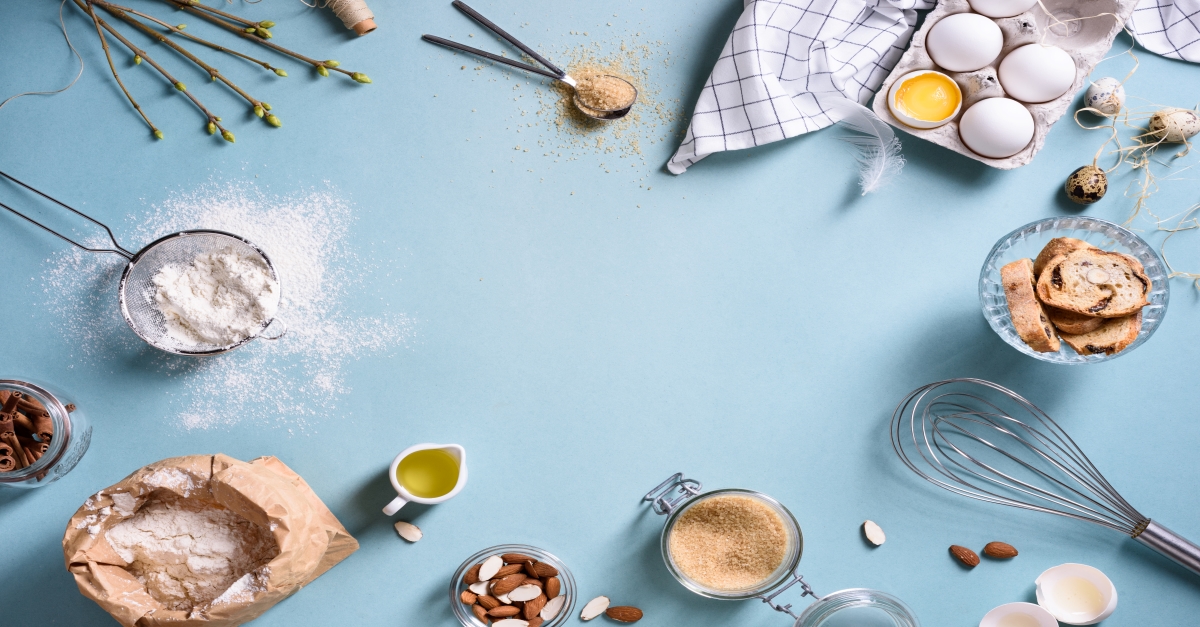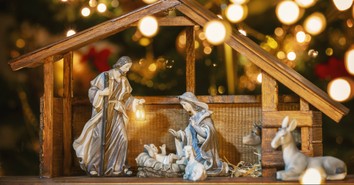Resurrection Rolls: A Family Easter Treat for Kids and Grownups

Whether you’re looking for a meaningful tradition to start with your family or searching for a fun activity to help bring the Easter story to life for children—Resurrection Rolls, otherwise known as Empty Tomb Rolls, are a sweet reminder of Christ’s triumph over the grave.
Get your free Easter Prayer and Scripture Guide HERE to reflect on the meaning and importance of Christ's resurrection.
The History Behind the Resurrection Rolls Recipe
Long before live cooking shows were all the rage, Pillsbury hosted an annual baking contest called the Pillsbury Bake-Off. This ground-breaking competition was first introduced in 1949 to give American homemakers a chance to share their best Pillsbury recipes in hopes of winning the $25,000 grand prize.
In 1969, Minnesota native Mrs. Edna Holmgren Walker took home the Bake-Off grand prize for her Magic Marshmallow Crescent Puffs. It’s unclear who first adapted the winning recipe as a tasty illustration for Christ’s empty tomb. But for over 50 years the sticky, hollow buns, renamed Resurrection Rolls, have continued winning the smiles of families all over the world during Easter time.

How to Make Resurrection Rolls
Resurrection Rolls have stood the test of time because the recipe ingredients are easy to find, and the baking instructions are simple to follow. These light and gooey treats are delicious, as is. But feel free to use your own homemade bread dough in place of the store-bought crescent rolls or add an icing drizzle after baking for extra flair.
Here are the basic steps for making Resurrection Rolls—followed by detailed instructions for those who’d like to use the recipe to teach children a few powerful truths about Easter:
Ingredients:
* 1 (8 count) can refrigerated crescent rolls
* 8 large marshmallows
* ¼ cup butter, melted
* ¼ cup white sugar
* 2 tablespoons ground cinnamon

Basic Instructions:
Step 1—Preheat oven to 375 degrees F (190 degrees C).
Step 2—Line a muffin tin with eight cupcake liners.
Step 3—Combine sugar and cinnamon in a small bowl. Set aside.
Step 4—Dip marshmallows in melted butter, then coat in cinnamon-sugar mixture.
Step 5—Place each coated marshmallow in the center of one crescent roll segment, fold dough around the marshmallow, and roll in your hand until a seamless ball forms.
Step 6—Coat the spheres in the remaining butter and cinnamon mixture and place in the muffin tin.
Step 7—Bake for 12-15 minutes, or until golden.
Preparation for Interactive Object Lesson:
If you’re using this recipe as a hands-on lesson for a group of kids, be sure to prepare each child’s workstation, and your own, with a strip of wax paper or parchment paper for easy cleanup. Also, encourage hand washing—as little fingers will cover every inch of the dough.
—Preheat oven to 375 degrees F (190 degrees C).
—Line eight muffin tins with paper cupcake liners.
—Place ¼ cup butter in a small bowl and melt in the microwave for 30 seconds. Set aside.
—Combine ¼ cup sugar with 2 tablespoons of cinnamon in a small bowl. Set aside.
—Place one large marshmallow at each workstation.
—Place one triangular segment of crescent dough at each workstation.
—Place one toothpick at each workstation.

Photo Credit: Rawf8/Getty Images
Detailed Instructions and Symbolism for Object Lesson
Begin the object lesson by opening your Bible and reading the account of Jesus’s death and resurrection. Depending on the maturity level of your group, you may consider reading the account from a Biblically-based, age-appropriate, story-book Bible like this one.
Pray and ask God to make His Word clear to everyone participating in the activity.
Before the children begin making their own Resurrection Rolls, fully assemble one as an example, describing the symbolism as you go. This will allow the child to engage in the object lesson without becoming distracted by the assembly process. Here’s a quick reference for the symbolic elements, but feel free to use the symbolism script provided with each step below.
Marshmallow—Jesus’s purity
Cinnamon sugar mixture—sin
Toothpick—Jesus’s was “pierced” for our sin
Crescent dough—Jesus’s tomb
Step 1—Hold up one marshmallow for the group to observe.
Symbolism script: Jesus was the only person on earth who never did one bad thing. He was sinless. He never lied, never cheated, never disobeyed His parents, and never did anything else that made God sad. He was completely pure. This white marshmallow represents Jesus’s clean heart and perfect life. (1 Peter 2:22)
Step 2—Sprinkle a little of the cinnamon-sugar mixture into each child’s hand and encourage them to taste it. Ask if anyone can guess how many grains of sugar and how many small flecks of cinnamon are included in the bowl.
Symbolism script: Our sins may taste sweet for a season, and they may seem small, but each one is very dangerous. Sin kills our relationship with God. Every grain of sin—one lie, one bad attitude, one act of disobedience—makes it impossible for us to be near God, because God is Holy. God loves us and doesn’t want us to be apart from Him, so He sent His only Son, Jesus, to earth to make a way for our sins to be forgiven (Romans 6:23).
Step 3—Insert a toothpick into the end of the marshmallow.
Symbolism script: Because Jesus was sinless, He was the only one who could rescue us from our sins. Wicked men hurt and killed Jesus—and He let them—because that was the only way to bring us close to God again. The toothpick represents how Jesus was hurt and then died on the cross for our sins (Isaiah 53:5, 1 Peter 2:24, Acts 2:23).
Step 4—Roll the marshmallow in melted butter, then coat it in the cinnamon-sugar mixture.
Symbolism script: On the cross, Jesus took the blame for every bad thing we’ve ever done or ever will do. Our sins were placed upon His sinless body (2 Corinthians 5:21).
Step 5—Place the coated marshmallow in the center of the crescent roll and remove the toothpick. Wrap the crescent completely around the marshmallow and roll the dough in your hands until a seamless sphere is formed. Coat the sphere in the remaining butter and cinnamon mixture, place the finished product in the lined muffin tin, and bake for 12-15 minutes.
Symbolism script: After Jesus died, His friends placed His body in a cave, called a tomb, and rolled a large stone in front of the entrance. The dough around the marshmallow represents the tomb where they laid Jesus’s body (John 19:41-42).
Step 6—While the rolls are baking, explain to the children that Jesus’s disciples and friends were very sad when Jesus died. They didn’t understand God’s plan yet. All they knew was that their Lord was dead. They thought they’d never see Him again. They thought Jesus would remain in the tomb forever. But early on the third morning, several of Jesus’s friends went to the tomb and discovered that the stone had been rolled away from the cave entrance! (Matthew 28:1-8, Mark 16:2-8, Luke 24:1-8, John 20:1-10)
Step 7—Remove Resurrection Rolls from the oven and cool on a baking rack for five minutes. Then, take one roll from the batch and carefully pull the top of the roll apart from the bottom to reveal the hollow space inside.
Symbolism script: When Jesus’s friends entered the tomb, they were shocked to see that He was not there. The tomb was empty. An angel told them that Jesus had risen from the dead. He was alive! And Jesus is still alive today. He lives in the heart of everyone who puts their trust in Him. Because Jesus died and rose again, we can be near to God forever and ever.
Note: As you guide the group step by step in making their own rolls, give them an opportunity to explain, in their own words, the symbolism they learned from your example. Offer reminders, answer questions, and provide assistance as needed.

Other Ways to Use Resurrection Rolls to Talk About Easter
Studies show that those who engage in interactive learning activities are better equipped to process and retain information. No other information is more important to impart to our kids than the truth about Jesus—His birth, death, and resurrection.
If you don’t have time for the full Resurrection Rolls demonstration, here are a few ways you can use the finished product as a conversation starter to discuss the importance of Easter:
—Prepare a basket of Resurrection Rolls for breakfast on Easter morning, and when your child asks why the buns are hollow inside, explain the correlation between the treat and Jesus’s empty tomb.
—Engage older kids in the fun by allowing them to take ownership of the Resurrection Rolls tradition in your family. Assign them the task of preparing the rolls and give them center stage when it comes time to explain their symbolism. Let Resurrection Rolls be your big kids’ special contribution to holiday gatherings every Easter. It’s never too early—or too late—to train children in the art of sharing the Gospel.
—Once our younger kiddos have grasped the symbolism of Resurrection Rolls, they’ll most likely be eager to share what they’ve learned with others. Encourage your littles to offer the finished treats to friends or family members who might not otherwise be opened to hearing the Easter message. It’s amazing the power our little ones wield when God uses their simple, childlike faith to share profound Biblical truth.
Photo Credit: ©GettyImages/jacoblund
This article is part of our larger Holy Week and Easter resource library centered around the events leading up to the death and resurrection of Jesus Christ. We hope these articles help you understand the meaning and story behind important Christian holidays and dates and encourage you as you take time to reflect on all that God has done for us through his son Jesus Christ!
What is Lent? It's Meaning and Why We Celebrate
When is Lent? When Does Lent Start and End?
What is the Meaning Ash Wednesday?
What is Holy Week?
What Is the Meaning of Palm Sunday?
What is the Meaning of Holy Monday?
What is Maundy Thursday?
What Is Good Friday and Why is it Good?
Good Friday Prayer
What Does Holy Saturday Mean?
What Is the Easter?
Easter Prayers
Powerful Facts About the Cross of Jesus
Originally published February 22, 2022.







